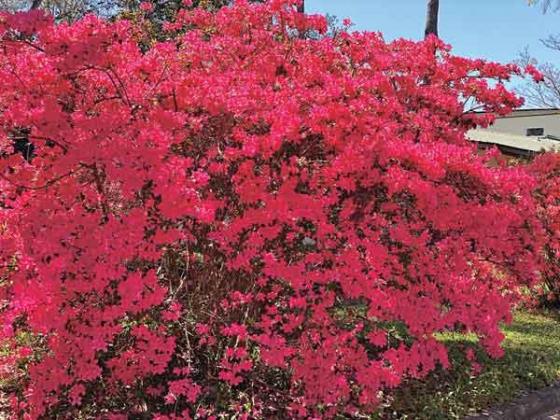
Heather Kirk-Ballard LSU AgCenter horticulturist
The azaleas are showing off right now, putting on their annual spring spectacular despite the recent sleet, snow and extended freezing temperatures across the state. I got a few frantic phone calls about whether delicate azalea buds would be damaged. Luckily, these flowers are cold hardy.
Azaleas are one of the most beloved flowering shrubs for Southern gardens. When I recently got a call from a tourist from Vermont concerned about what happened to the azaleas during the recent freezes, I realized just how special it was. This person travels each spring to see the spectacular display.
By far, the South’s most popular flowering shrub is the azalea — namely, the Southern Indica azaleas (Rhododendron indicum) from Japan. One of the oldest collections was started in the early 1800s at Magnolia Gardens near Charleston, South Carolina.
In addition to Asia, azaleas are native to North America and Europe. In general, azaleas prefer an acidic soil with a pH of 5.0 to 6.0 that is rich in organic matter and well drained. Azaleas have a broad, mounding growth habit and grow to an average size of 6 feet high by 6 feet wide. Some varieties are more compact at 2 feet by 2 feet, and others grow up to 10 feet by 10 feet.
They can be grown in full sun but prefer partial shade and naturally grow as an understory plant to pine trees. Most types bloom in the spring, but some varieties have become popular for later-season blooms. And there are many colors to choose from.
Today, there are thousands of different cultivars of azaleas. Azalea breeders have been selecting and breeding these plants for hundreds of years. Louisiana boasts its own famous breeder: Buddy Lee from Folsom, Louisiana. He developed the Encore azalea, one of the most popular repeat-blooming varieties in America.
The Encore series has 33 varieties to offer. They bloom, spring, summer and fall. LSU AgCenter research determined an average of 21 to 32 weeks of bloom. Some varieties are Autumn Embers, Autumn Royalty, Autumn Fire, Autumn Twist and Autumn Princess.
Spring is a great time to plant azaleas. Be sure to check soil pH and amend the soil with elemental sulfur, aluminum sulfate or ammonium sulfate to help bring the pH down if needed. Fertilize in late winter and early spring for the best blooms and greener foliage.
Be sure to mulch your beds to conserve soil moisture, suppress weeds and provide a source of organic matter. Prune very soon after flowers have bloomed, removing a small amount of wood annually to keep plants compact and thin out tall, spindly stems. Buds are set on old wood, so do not prune in summer, fall or winter, or you will miss next year’s show.
Azaleas do have some issues, but they are easily controlled if caught early and preventative measures are taken. Some common pests include lacebugs, bark scale and spider mites. Petal blight, leaf gall and root rot are common diseases.
Look for bronzing on older leaves as a sign of spider mites and mottling or tiny brown spots on the leaf when lacebugs are present. Lacebugs are found on the underside of leaves, making them more difficult to control. They often cause problems in late winter and early spring.
Use a systemic insecticide with the active ingredient imidacloprid to control mites, scale and lacebugs. Remember, you must re-treat in seven to 10 days to kill newly hatched pests.
Many common diseases of azaleas are caused by fungal pathogens that can be reduced with proper soil drainage.
Indian azalea flowers can grow anywhere from 2 to 3 1/2 inches across for the most grandiose display. Formosa, Dixie Beauty, George L. Tabor and Mrs. G.G. Gerbing are by far the stars of this category. There are several other varieties of Indian Azaleas, including Daphne Salmon, Fielder’s White, Judge Solomon, President Clay, Pride of Mobile and Southern Charm to name a few.
The Kurume azaleas are dwarf azaleas growing to 4 to 6 feet in height by 3 feet in width at a slower, denser rate. Flowers are only 1 to 2 inches across. Popular varieties are Christmas Cheer, Coral Bells, Hershey’s Red, H.H. Hume, Hinodegiri and Snow.
The Satsuki azaleas bloom later in the spring around April and May. Popular varieties are Gyokushin, Pink Gumpo, Pink Macrantha, Red Gumpo, White Gumpo and Hardy Gardenia. For a complete list, description and details of each variety listed, search for “azaleas publication 1295” at www.lsuagcenter.com.
Native azaleas are deciduous, and they attract hummingbirds, butterflies and other pollinators with their colorful, nectar-rich flowers. Flame of Florida azalea (Rhododendron austrinum) and honeysuckle azalea (Rhododendron canescens) are two found readily at local nurseries.
Also look for the Louisiana Super Plant pick Conversation Piece azalea, which is noted for its large pink flowers that are nearly 4 inches across. They are repeat bloomers and cold hardy.
